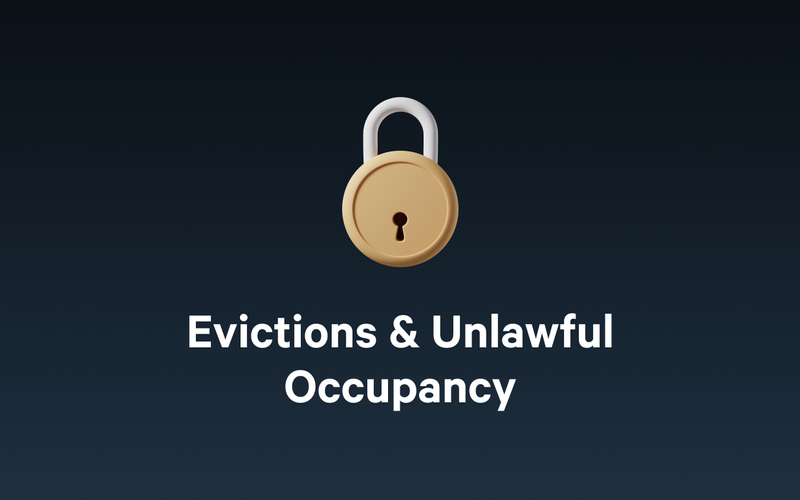Dealing with unlawful occupancy in rental properties can happen, even with preventative measures in place. It is a challenging and time-consuming task that every property manager and landlord may encounter at some point.
In this post, we will explore the definitions of squatter and resident eviction, highlight the preventive measures Arrived implements to protect investors, and outline ways to reduce your exposure to adverse outcomes from the eviction process.
Finding the Right Property Management Partners
Maintaining a high occupancy rate and maximizing returns for investors starts with finding the right property management partner. Arrived works with experienced third-party property managers to operate in each market, and these professionals have the expertise and knowledge to handle all aspects of property management, from tenant screening and lease agreements to maintenance and repairs.
In cases of unlawful occupancy or lease violations due to non-payment, Arrived works closely with these partners to ensure they take the proper steps to resolve the situation according to our established playbook.
Preventative Measures
Before a problem can even present itself, property managers proactively implement various measures to prevent unauthorized individuals from occupying properties. These measures include installing digital locks with one-time access codes, ensuring that only authorized individuals can enter the premises.
Managers also perform regular wellness checks at vacant properties to identify unauthorized occupants before they become a significant issue. So, even if a trespasser can gain entry and occupy a property, these routine checks ensure they are detected early, and the property manager can move to resolve the situation.
Resident evictions
When rent goes unpaid, the response from property managers is rarely a one-size-fits-all approach. In many cases, the first step is issuing a “Pay or Quit” notice—a standard industry practice that formally notifies residents of overdue rent and gives them a limited time to pay or vacate the premises. This notice is not an eviction per se, but rather a compliance request and a helpful guardrail to encourage residents to stay current in their payments.
Property managers who often utilize these notices as an early intervention tool. They are frequently effective in bringing accounts current and are a far more constructive first step than relying solely on late fees. By clearly communicating expectations, this step helps maximize tenancy duration while protecting the property’s cash flow.
It’s important to distinguish this from a full legal eviction, which is typically a last resort. A formal eviction process—one that results in removing a resident from the property—only proceeds after all other options have been exhausted and is handled by professionals who ensure compliance with local laws and tenant rights.
Eviction Process Overview
The eviction process involves several steps, varying in duration depending on the jurisdiction and type of eviction. Here is a general overview:
- Rent demand: If it is a resident eviction, a legal demand for payment or vacancy is issued, providing a specified date for compliance. The demand period typically ranges from 3 to 30 days, depending on the jurisdiction.
- Filing: Once the demand period expires, an eviction case is filed with the court. The filing process takes 1 to 10 days, and the resident usually has 5 to 14 days to respond.
- Summons: The court serves a summons to the resident, typically taking 5 to 21 days. The speed of service depends on the case volume and the backlog of the sheriff or the court’s process server.
- Answer & hearing: A hearing is scheduled if the resident answers the summons. The hearing date can range from 7 to 120 days and is affected by case volume, court backlog, and any actions requested by the judge.
- Judgement & Writ of Possession: The court awards possession to the landlord following the hearing. A default judgment may be requested if the resident fails to answer the summons. The judgment and waiting period for the Writ of Possession typically takes 1 to 7 days for default judgments and 7 to 30 days for regular judgments.
- Set out: Once the court issues the Writ of Possession, it is forwarded to the sheriff or magistrate for execution. The set-out process can take 10 to 120 days, depending on the availability and backlog of the Writs.
Additional Considerations
Eviction timelines can vary significantly depending on local laws and the nature of the case, and are often beyond our control. That said, our property managers take proactive steps—issuing notices promptly and coordinating with legal counsel as soon as the notice period ends—to help keep the process moving efficiently.
Squatter Evictions
Rarely, an individual may occupy uninhabited property. Dealing with squatters can be a challenging experience, but property managers have a set protocol to follow. If an unauthorized individual is found occupying a property, managers promptly alert the local authorities and follow the standard procedures based on local laws. It’s important to note that the process of removing squatters can vary significantly from state to state.
Addressing Market Challenges with Enhanced Protective Measures
In today's real estate landscape, certain markets present unique challenges that require tailored strategies. At Arrived, we continually monitor our rental markets. If we identify a market with elevated eviction or unlawful occupancy rates, we apply stricter resident screening criteria to help safeguard investor capital and promote consistent rental income.
Enhanced screening measures could include:
- Higher income-to-rent ratio: We may require a higher-than-industry income-to-rent ratio, along with a monthly household income, to ensure that residents can comfortably afford their rent.
- Stricter credit score standards: We may require a credit score that exceeds industry standards to select financially responsible residents.
- Increased security deposits: To mitigate potential risks, we may mandate increased security deposits for conditional applicants—those who fall below our pre-approval thresholds.
- Co-signer requirements: Conditional applicants must provide cosigners to guarantee lease obligations.
Final Thoughts
Managing a portfolio of rental homes involves navigating a range of operational challenges. With hundreds of properties in diverse markets, it’s not uncommon to encounter occasional issues such as extended vacancy periods, unauthorized occupants, maintenance delays, or property damage.
Our experienced team works diligently with professional property managers to address these situations efficiently and in accordance with applicable laws. While we aim to mitigate operational disruptions, such risks are inherent in real estate and underscore the importance of diversification. Spreading investments across multiple properties and markets can help reduce exposure to any single event or location.
In instances where a property experiences an unusual event—such as unlawful occupancy—Arrived communicates proactively with investors to provide timely updates on the property’s status and the actions being taken.









